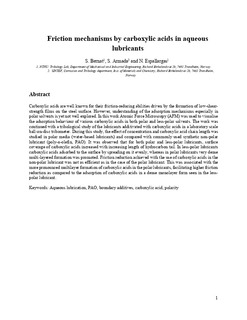Friction Mechanisms by Carboxylic Acids in Aqueous Lubricants
Journal article, Peer reviewed
Accepted version

View/
Date
2018Metadata
Show full item recordCollections
Original version
10.1007/s11249-018-1035-9Abstract
Carboxylic acids are well known for their friction-reducing abilities driven by the formation of low-shear-strength films on the steel surface. However, understanding of the adsorption mechanisms especially in polar solvents is yet not well explored. In this work, atomic force microscopy was used to visualise the adsorption behaviour of various carboxylic acids in both polar and less-polar solvents. The work was continued with a tribological study of the lubricants additivated with carboxylic acids in a laboratory scale ball-on-disc tribometer. During this study, the effect of concentration and carboxylic acid chain length was studied in polar media (water-based lubricants) and compared with commonly used synthetic non-polar lubricant (poly-α-olefin, PAO). It was observed that for both polar and less-polar lubricants, surface coverage of carboxylic acids increased with increasing length of hydrocarbon tail. In less-polar lubricants, carboxylic acids adsorbed to the surface by spreading on it evenly, whereas in polar lubricants, very dense multi-layered formation was promoted. Friction reduction achieved with the use of carboxylic acids in the non-polar lubricant was not as efficient as in the case of the polar lubricant. This was associated with the more pronounced multilayer formation of carboxylic acids in the polar lubricants, facilitating higher friction reduction as compared to the adsorption of carboxylic acids in a dense monolayer form seen in the less-polar lubricant.